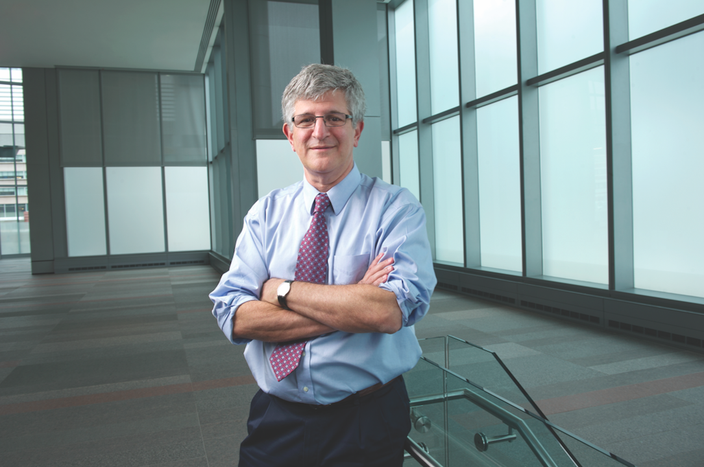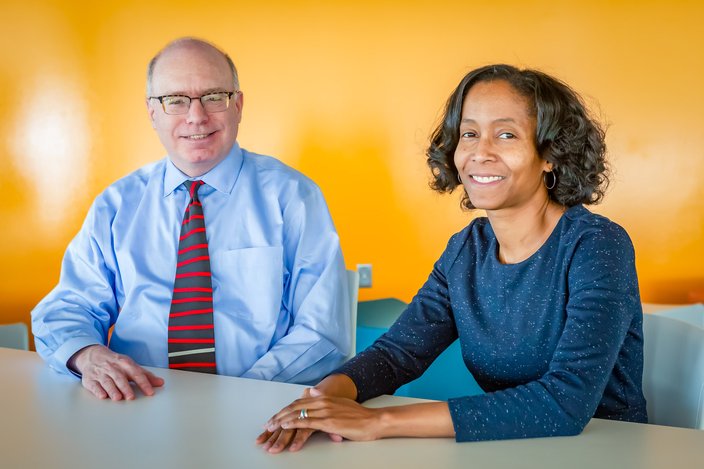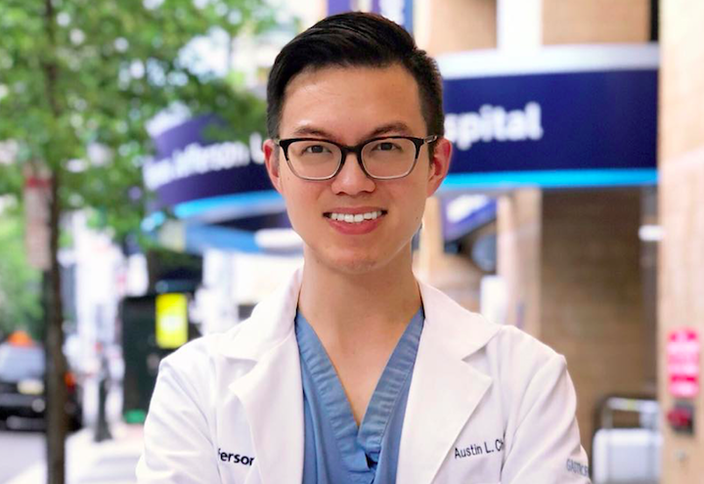
January 09, 2019
 PhillyVoice illustration/Image credits: NIAID via Flicker Creative Commons and Burst from Pexels
PhillyVoice illustration/Image credits: NIAID via Flicker Creative Commons and Burst from Pexels
Humans' relationship with bacteria is complex. Sometimes they are helpful to our bodies, but other times they are dangerous. That relationship can also describe medical information on the internet and social media. There are trustworthy sources of information, but disreputable sources are proliferating, and experts say they could be endangering people's lives.
A YouTube video promoting an herbal remedy for prostate cancer opens with a flashy infographic detailing the purported benefits of the treatment.
Set against a colorful depiction of a cancerous prostate, a voiceover describes the treatment: Natural herbal extracts are injected into the prostate, eliminating cancerous cells and returning the gland to normal.
The video, posted by a Chinese prostate clinic, has been viewed more than 340,000 times, placing it among the most-viewed prostate cancer-related videos on the social media website.
But it is highly misinformative, according to Dr. Stacy Loeb, a urologist at New York University Langone Health. The procedure is neither a guideline-recommended treatment, nor are its proclaimed effects supported by scientific evidence.
The video stands as a glowing example of the medical misinformation that permeates the internet and social media. To an untrained eye, such information can appear reputable, potentially sending an unwitting patient down a perilous path.
And it is spreading all over the internet.
Loeb found all sorts of misinformation when she examined the top 150 YouTube videos relating to prostate cancer screenings and treatment. Some videos overlooked significant drawbacks. Others included outdated information. Only a few provided references.
In all, 77 percent of those 150 videos contained misinformation or biased content either within the video or among the comments, where users at times offered or received medical advice from strangers. Collectively, those videos had been viewed more than 6 million times.
"Basically, the bottom line is if you go on YouTube and look up prostate cancer, you are very likely to land on something that is misinformative or biased," said Loeb, whose findings were published last November in the European Urology journal.
It is next to impossible to quantify the amount of misinformation circulating across the internet. But it seemingly extends into every area of medicine. Loeb's study likely represents a fragment of it.
Worse yet, that misinformation has proven dangerous and, in some cases, even deadly. And it provokes serious questions for both patients and medical professionals.
What steps can patients take to ensure the information they view online is sound medical advice? How can they distinguish between actual scientific data and misinformation – especially when they are presented so similarly? And what responsibility do clinicians and scientists have to combat all this misinformation?
Dr. Paul Offit, of the Children's Hospital of Philadelphia, says he treats children with preventable diseases every year. Often times, he says, their parents refused to vaccinate them because of bad information they found online.
Perhaps nothing illustrates the prevalence and dangers of medical misinformation better than the anti-vaccine movement. And few people have been more outspoken against it than Dr. Paul Offit, director of the Vaccine Education Center at the Children's Hospital of Philadelphia.
Every year, Offit treats children who have contracted a preventable disease because their parents refused to vaccinate them. In the worst cases, those children die.
"Invariably, it's because a parent made a decision not to give a particular vaccine based on bad information they found on the internet," said Offit, who spent years developing a rotavirus vaccine. "I just found it unconscionable that that was happening."
The percentage of unvaccinated American children continues to rise. According to the U.S. Centers for Disease Control and Prevention, 1.3 percent of children born in 2015 had not received any vaccinations by the time they turned age two. That figure has quadrupled since 2001, when it stood at just 0.3 percent.
Many parents who choose not to vaccinate their children believe those inoculations cause autism – despite at least 26 scientific studies rejecting any link.
It's a movement primarily based off a disproven study retracted eight years ago after its lead author, Andrew Wakefield, was found guilty of committing unethical conduct. Wakefield lost his medical license in England.
But it continues despite clear and potentially severe consequences. Notable measles outbreaks hit the United States in 2014, 2015 and 2017 – less than two decades after the disease was considered eliminated within the country.
Still, the anti-vaccine movement persists, fueled in part by celebrities and all sorts of unreliable sources online.
"I think the people who tell the best story often are the ones who are able to rise above the noise." – Dr. Paul Offit, Children's Hospital of Philadelphia
"That's where this war is being fought – on the internet," Offit said. "That's where most people get their information these days."
To a certain extent, Offit empathizes with the plight of parents. The Information Age has given a sounding board to all sorts of people, no matter their qualifications. Not too long ago, network television stations and newspapers played the role of gatekeepers.
"The internet is unaccountable," Offit said. "It's unverifiable. Therefore, it's full of great and awful information."
For some, the misinformation acts as a mirage. Despite years of research, scientists have yet to identify all of the causes or find a cure for autism. So, Offit said he understands why some parents become so enticed by people, like Wakefield, who claim to have an answer even as everyone else comes up empty-handed.
"He still has a following even though 17 studies have proven that MMR does not cause autism," Offit said, referencing the vaccine for measles, mumps and rubella. "He still has his followers who like his certainty in an area where there can't be certainty."
Rather than delve into the internet, Offit recommended patients identify a physician they can trust.
"In the end, you find a doctor that you think is trustworthy and you trust them," Offit said. "It's hard to educate yourself."
In his latest book, titled "Bad Advice," Offit wrote that the problem isn't that there's so much conflicting information out there. Rather, it's that there is so much misleading information. And without a medical background, it can be challenging to differentiate between the two.
If a parent wanted to thoroughly research the effects of the chicken pox vaccine, they would need to read several hundred medical papers, Offit said. And that would require them to have knowledge in all sorts of areas – virology, immunology, epidemiology and clinical medicine, among others.
The vast majority neither have the knowledge, nor the time, to do so.
That's why both the the CDC and the American Academy of Pediatric have advisory boards filled with experts who can read those papers and make appropriate recommendations. As unpopular as it may be, Offit urged people to trust them.
"That is just not a message that sells in the 21st century – 'Trust us, we're the experts,'" Offit said.
Only 34 percent of Americans express great confidence in medical leaders, according to The New York Times. That's down from more than 75 percent in 1966.
Patients often walk into Offit's clinic claiming they have researched vaccines, he said. By that, they mean they have gone online and read a bunch of people's opinions on the subject. They have not read the actual research papers.
"If you're going to do that, at least get good opinions," Offit said. "Don't go to Natural News for this. Don't go to web sites that are selling something. Go to websites like the Mayo Clinic, or the Children's Hospital of Philadelphia, or Centers for Disease Control and Prevention, that are at least grounded in fact."
Because people don't have the background needed to sort good data from bad data, they instead to turn to believability, Offit wrote in "Bad Advice." Thus, the correct information doesn't always win out.
"I think we're human, so we're compelled by stories," Offit said. "I think the people who tell the best story often are the ones who are able to rise above the noise. That's what we need to do. We need to be able to tell a compelling story."
Dr. David Asch and Dr. Raina Merchant recently published a paper outlining steps that medical professionals can take to counteract misinformation online.
Medical researchers and clinicians are accustomed to disseminating information through a lengthy, fully-vetted process.
Research studies are subjected to peer review prior to publication. Those same studies are nuanced, often with entire sections dedicated to their limitations. And their findings must be repeated again and again before being adopted as scientific truths.
The internet, of course, is a bit less rigorous.
It's a world where the medical opinions of celebrities can carry as much sway as a doctor's expert advice. Snake oil salesmen, once relegated to back alleys, have full reign. Anyone with a decent following can draw followers to misinformation, even while holding the best intentions.
With social media flooded by unsubstantiated messages, clinicians are recognizing the need to counteract medical misinformation online. To do so, they need to find ways to make science more accessible and understandable.
"We don't want to dumb down science," said Dr. Raina Merchant, director of Penn Medicine's Center for Digital Health. "But we want to make it easier to understand what the take-home message was.
"... If we come up with scientific recommendations and it's hard for people to understand them, it makes it a lot easier for misinterpretation, whether it's intended to be nefarious or not."
Merchant and her colleague, Dr. David Asch, penned a joint viewpoint in the Journal of the American Medical Association last November, arguing that researchers must be proactive in defending their objective findings against erroneous claims.
In some cases, they said, that may mean taking an adversarial stance to debunk myths. That strategy carries some risk, as doing so could further decrease trust in the scientific enterprise. But they found the alternatives worse.
"We love our lessons in stories. It's interesting that we don't take advantage of those skills when we're trying to communicate facts." – Dr. David Asch, Penn Medicine
"I do think that it makes sense to try it in a measured way that doesn't give up the discipline and the measured qualities of science, to call out falsehoods and to undermine them," said Asch, executive director of the Penn Medicine Center for Health Care Innovation.
At the very least, clinicians as a whole need to become more engaged online. There, they can observe the misinformation that their patients possibly are reading. And they can enter into the dialogue, sharing accurate information.
"We can go completely on the one side and say we should only direct people to these accepted, vetted sources that usually get it right," Merchant said. "But part of what social media has enabled is the ability for people to share information with each other. Sometimes, this peer-to-peer support can be helpful."
Merchant and Asch called for coordinated social media campaigns designed to engage patients on the platforms they use. Though numerous researchers already thoughtfully engage social media users, most cannot compete with bots that churn out dozens of posts each day, reaching millions of people.
Bots often are used to influence public opinion or sell products. For instance, one study found that bots might be driving much of Twitter users' discussions on e-cigarettes – a product that can help adults quit smoking, but has hooked many teens on nicotine.
Merchant and Asch also stressed the need for researchers to adopt a more emotional and narrative-driven approach to disseminating information.
Researchers mostly have been taught to write in a dispassionate form, emphasizing facts and avoiding anecdotes. That's a great way to generate objective evidence, Asch said. But it's a poor way to convey it.
People respond to stories, Asch said. He pointed to the parables of the Bible and Greek myths like "The Odyssey."
"We love our lessons in stories," Asch said. "It's interesting that we don't take advantage of those skills when we're trying to communicate facts."
But they can be effective tools in combating misinformation.
"If there are good guys and bad guys, good guys and bad guys have the same tools," Asch said. "It's helping the good guys learn how to use the tools that, at the moment, have only been used by the bad guys."
Dr. Austin Chiang, a gastroenterologist at Jefferson Health, launched an Instagram campaign, #VerifyHealthCare, urging medical professionals to post their credentials so that social media users would recognize them as qualified sources of medical information.
Count Dr. Austin Chiang among the physicians leading the charge online.
A gastroenterologist at Jefferson Health, Chiang recently became the health system's chief medical social media officer. It's a newly-created role that only a few medical institutions have established. And it's one designed to increase social media engagement among Jefferson clinicians.
"Part of the reason why the anti-vaccine movement took off was because there weren't enough qualified medical professionals involved in the conversation online," Chiang said. "We're burdened with all the existing responsibilities that we have and often there's no emphasis for physicians, or other clinicians, to have a social media presence.
"That's what I'm trying to demonstrate. We really need to be involved in those social media conversations."
Last September, Chiang launched an Instagram campaign, #VerifyHealthCare, that urged medical practitioners to post a picture alongside their credentials – everything from their medical degrees to their certifications to their clinical research.
The campaign, which generated more than 1,600 Instagram posts and spread to Twitter, alerted viewers to their areas of expertise, adding credibility to the medical information they shared on social media. It also pushed viewers to verify the medical backgrounds of social media influencers before accepting any medical information they might share.
"We wanted people to double- and triple-check who they were trusting online," Chiang said.
Within GI, Chiang said he has seen unsubstantiated claims regarding colon cleanses and detox teas, neither of which have been proven to remove toxins from the digestive system.
After all, not everyone posing online in a white coat is representing themselves accurately – even if they have a strong social media following. Sometimes, Chiang said, it is even hard for trained medical professionals to spot the difference.
Prior to his campaign, Chiang found chiropractors and osteopathic doctors who were not appropriately differentiating their credentials online. Sometimes, Allied Health professionals were not making it clear that they were not physicians. And medical students did not always disclose that they had not completed their training.
"It's unrealistic to think that they will not have additional questions. Rather than allowing them to search for additional information on their own, we can be more proactive." – Dr. Stacy Loeb, New York University
With so much medical misinformation already propagating online, Chiang found these misrepresentations counterproductive.
"Especially on Instagram, it's a very visual platform," Chiang said. "There's a lot of people who are putting white coats on and stethoscopes. A lot of people have really good intentions sharing health knowledge on there."
But if physicians are to take a more active role on social media, there needs to be some rules governing appropriate conduct. Chiang hopes to play a role in developing them.
"There needs to be more guidance and more standards for clinicians using social media," Chiang said. "Not everyone is using it properly. There's no consensus yet."
Nevertheless, Chiang recognizes a need for more clinicians to hop on social media. Not only can they challenge misinformation, but they can direct people to accurate information and sources.
"For people who have expertise in those areas, we really should be involved in those conversations and not just sitting back," Chiang said. "I think the focus has been all this misinformation, but there's a lot of good out there."
The abundance of medical misinformation can prove particularly harmful to some of the most vulnerable patients, who often find themselves turning to the internet in the face of devastating news.
"When you've been diagnosed with cancer, this is one of – if not the most – difficult moments in your life," said Julie DiBiase, vice president of original content at the Prostate Cancer Foundation. "People are searching. They're really searching for good information. They're searching for guidance."
But they particularly want to hear optimistic information, DiBiase said. And that can make them particularly susceptible to misinformation.
"The solution to that, as a consumer, you have to be a detective," DiBiase said. "You have to verify the source. Go to that website. Make sure that they can back it up."
As a clinician, Loeb said she tries to point her patients to reliable information. She recognizes that many of her patients are going to seek out additional information after receiving their diagnoses.
So, she takes a few minutes to highlight the resources available at the Prostate Cancer Foundation. In some cases, Loeb signs people up to receive that information for them.
"It's unrealistic to think that they will not have additional questions," Loeb said. "Rather than allowing them to search for additional information on their own, we can be more proactive."
When it comes to protecting people from medical misinformation, there's a role for everyone.
Follow John & PhillyVoice on Twitter: @WriterJohnKopp | @thePhillyVoice
Like us on Facebook: PhillyVoice
Add John's RSS feed to your feed reader
Have a news tip? Let us know.
 Courtesy/Children's Hospital of Philadelphia
Courtesy/Children's Hospital of Philadelphia Thom Carroll/PhillyVoice
Thom Carroll/PhillyVoice Courtesy/Austin Chiang
Courtesy/Austin Chiang